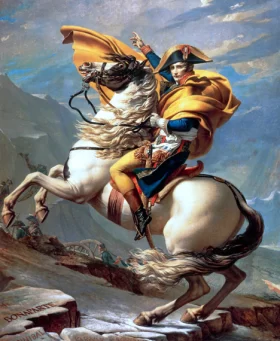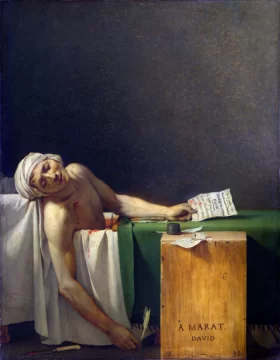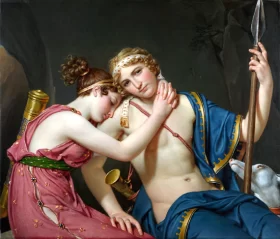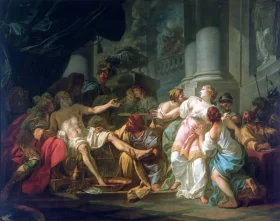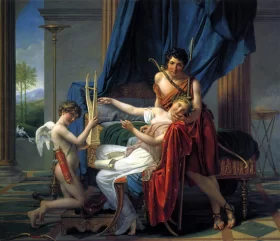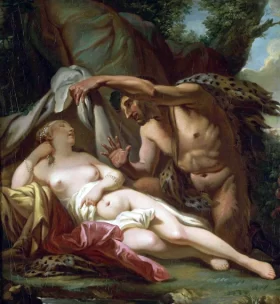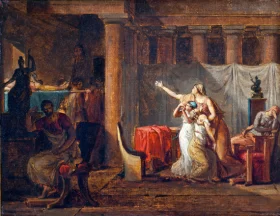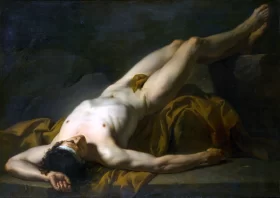사이트 전체 5% 할인 | 결제 시 KMKR5 코드를 사용하세요.
- Choose your Country
사이트 전체 5% 할인 | 결제 시 KMKR5 코드를 사용하세요.
신고전주의
The Neoclassical art movement emerged in the mid-18th century as a reaction against the ornate and frivolous Rococo style. It drew inspiration from the art and culture of ancient Greece and Rome, seeking to revive the principles of classical antiquity. Neoclassical artists embraced rationality, order, and idealized forms, rejecting the extravagance and emotionalism of the preceding Baroque and Rococo periods. The movement spread across Europe, influencing architecture, sculpture, painting, and decorative arts, and leaving a lasting impact on the history of art.
Neoclassical art was characterized by its emphasis on simplicity, clarity, and balance. Artists sought to capture the ideals of reason, virtue, and civic duty through their works. They drew inspiration from classical mythology, history, and literature, depicting heroic figures, mythological scenes, and allegorical subjects. The aim was to create art that conveyed moral and intellectual values, evoking a sense of timelessness and universality.
One of the prominent figures of the Neoclassical movement was the French painter Jacques-Louis David. He is considered the quintessential Neoclassical artist, known for his iconic paintings that reflect the spirit and ideals of the French Revolution. David’s works, such as “The Death of Socrates” and “The Oath of the Horatii,” display a meticulous attention to detail, strong composition, and a focus on heroic and noble subjects.
The Neoclassical style also had a profound influence on sculpture. Sculptors like Antonio Canova and Jean-Antoine Houdon created works that celebrated the beauty of the human form while embodying the classical ideals of harmony, proportion, and idealization. Canova’s marble sculptures, such as “Cupid and Psyche” and “Napoleon as Mars the Peacemaker,” exude a sense of grace and perfection, harkening back to the aesthetics of ancient Greece and Rome.
Neoclassical architecture aimed to revive the architectural principles of ancient Greece and Rome. Architects like Étienne-Louis Boullée and Jean-Nicolas-Louis Durand promoted a return to classical forms, emphasizing symmetry, order, and rationality. The buildings of this era featured grand facades, columns, pediments, and geometric proportions, evoking a sense of grandeur and civic pride.
The Neoclassical movement extended its influence beyond the realms of painting, sculpture, and architecture. It played a significant role in shaping the decorative arts, interior design, and even fashion. Neoclassical motifs, such as urns, laurel wreaths, and classical figures, adorned furniture, ceramics, textiles, and jewelry, reflecting a broader cultural fascination with the ideals of ancient Greece and Rome.
The Neoclassical movement reached its peak in the late 18th and early 19th centuries, coinciding with the Age of Enlightenment and the rise of nationalism. The ideals of reason, order, and virtue resonated with the intellectual climate of the time, as artists and thinkers sought to reclaim the values of classical antiquity in the face of social and political change.
However, the Neoclassical movement eventually faced criticism for its perceived rigidity and lack of emotional depth. As the 19th century progressed, Romanticism emerged as a counter-movement, emphasizing individual expression, emotion, and imagination. The Romantic artists rejected the formalism and restraint of Neoclassicism in favor of a more subjective and passionate approach to art.
Despite its eventual decline in popularity, the Neoclassical movement left a profound impact on the development of Western art. It laid the foundation for subsequent artistic movements and influenced generations of artists who sought to combine classical ideals with their own personal visions.
In conclusion, the Neoclassical art movement of the 18th and 19th centuries sought to revive the principles of classical antiquity in response to the excesses of the Rococo style. It emphasized rationality, order, and idealized forms, capturing the moral and intellectual values of the time. Neoclassical art encompassed painting, sculpture, architecture, and decorative arts, leaving a lasting legacy that continues to shape the artistic landscape.
Read more70개 결과 출력

Napoleon crossing the Alps (Malmaison version) 1800
으로 자크루이 데이비드크기 시작 ₩300,189
Napoleon Crossing the Alps (Charlottenburg version) 1801
으로 자크루이 데이비드크기 시작 ₩292,239
Napoleon Crossing the Alps (Belvedere version) 1801
으로 자크루이 데이비드크기 시작 ₩296,219
Napoleon Crossing the Alps (First Versailles version) 1802
으로 자크루이 데이비드크기 시작 ₩292,239
The Death of Socrates 1787
으로 자크루이 데이비드크기 시작 ₩415,529
Oath of the Horatii 1786
으로 자크루이 데이비드크기 시작 ₩361,319
The Lictors Bring to Brutus the Bodies of His Sons 1789
으로 자크루이 데이비드크기 시작 ₩378,529
Apollo and Diana Attacking the Children of Niobe 1772
으로 자크루이 데이비드크기 시작 ₩373,229
Marat Assassinated 1793
으로 자크루이 데이비드크기 시작 ₩308,139
Mars Being Disarmed by Venus and the Three Graces 1824
으로 자크루이 데이비드크기 시작 ₩340,699
The Farewell of Telemachus and Eucharis 1818
으로 자크루이 데이비드크기 시작 ₩327,429
The Intervention of the Sabine Women
으로 자크루이 데이비드크기 시작 ₩371,619
Cupid and Psyche 1817
으로 자크루이 데이비드크기 시작 ₩350,979
Leonidas at Thermophylae
으로 자크루이 데이비드크기 시작 ₩383,819
Apelles Painting Campaspe in the Presence of Alexander the Great
으로 자크루이 데이비드크기 시작 ₩358,549
Erasistratus Discovers the Cause of Antiochus’s Disease, 1774
으로 자크루이 데이비드크기 시작 ₩366,469
The Anger of Achilles 1819
으로 자크루이 데이비드크기 시작 ₩394,399
The Death of Seneca
으로 자크루이 데이비드크기 시작 ₩361,319
Calliope Mourning Homer 1812
으로 자크루이 데이비드크기 시작 ₩321,929
Sappho and Phaon 1809
으로 자크루이 데이비드크기 시작 ₩340,699
The Return of Marcus Sextus
으로 자크루이 데이비드크기 시작 ₩312,759
Belisarius asking for Alms 1784
으로 자크루이 데이비드크기 시작 ₩335,539
Andromache Mourning Hector
으로 자크루이 데이비드크기 시작 ₩344,829
Jupiter et Antiope
으로 자크루이 데이비드크기 시작 ₩303,579
The Army takes an Oath to the Emperor after the Distribution of Eagles, 5 December 1804
으로 자크루이 데이비드크기 시작 ₩431,369
The Distribution of the Eagle Standards
으로 자크루이 데이비드크기 시작 ₩431,369
The Consecration of the Emperor Napoleon and the Coronation of Empress Joséphine on December 2, 1804
으로 자크루이 데이비드크기 시작 ₩417,879
The Coronation of Napoleon
으로 자크루이 데이비드크기 시작 ₩417,879
Antoine-Laurent Lavoisier and His Wife
으로 자크루이 데이비드크기 시작 ₩344,829
Mademoiselle Guimard as Terpsichore
으로 자크루이 데이비드크기 시작 ₩355,719
Young Woman with a Turban 1780
으로 자크루이 데이비드크기 시작 ₩296,219
Psyche Abandoned 1795
으로 자크루이 데이비드크기 시작 ₩304,169
Portrait of the Sisters Zénaïde and Charlotte Bonaparte 1821
으로 자크루이 데이비드크기 시작 ₩335,679
Zenaide and Carlotta Bonaparte
으로 자크루이 데이비드크기 시작 ₩335,679
The Emperor Napoleon in His Study at the Tuileries 1812
으로 자크루이 데이비드크기 시작 ₩359,669
Emperor Napoleon I 1807
으로 자크루이 데이비드크기 시작 ₩339,879
Portrait of Napoléon
으로 자크루이 데이비드크기 시작 ₩320,059
General Étienne-Maurice Gérard
으로 자크루이 데이비드크기 시작 ₩331,949
Comte Henri-Amédée-Mercure de Turenne-d’Aynac, 1816
으로 자크루이 데이비드크기 시작 ₩308,139
Portrait of the Comte de Turenne 1816
으로 자크루이 데이비드크기 시작 ₩324,019
Portrait of Madame Récamier
으로 자크루이 데이비드크기 시작 ₩316,089
Portrait of Madame de Verninac 1799
으로 자크루이 데이비드크기 시작 ₩308,139
Portrait of the Comtesse Vilain XIIII and her Daughter 1816
으로 자크루이 데이비드크기 시작 ₩340,259
Portrait of a young woman in White 1798
으로 자크루이 데이비드크기 시작 ₩312,119
Anne-Marie-Louise Thélusson, Countess of Sorcy
으로 자크루이 데이비드크기 시작 ₩316,089
Madame David
으로 자크루이 데이비드크기 시작 ₩300,189
Comtesse Daru 1810
으로 자크루이 데이비드크기 시작 ₩308,139
Madame de Pastoret and Her Son
으로 자크루이 데이비드크기 시작 ₩320,059
Portrait of a Young Woman 1800
으로 자크루이 데이비드크기 시작 ₩316,089
Madame François Buron 1769
으로 자크루이 데이비드크기 시작 ₩296,219
Portrait de la marquise d’Orvilliers 1790
으로 자크루이 데이비드크기 시작 ₩296,219
Suzanne Le Peletier de Saint-Fargeau 1804
으로 자크루이 데이비드크기 시작 ₩300,189
Madame Emilie Seriziat and Her Son 1795
으로 자크루이 데이비드크기 시작 ₩324,019
Laura-Emile-Felicite David, Baronne Meunier
으로 자크루이 데이비드크기 시작 ₩300,189
Portrait of Jacobus Blauw 1795
으로 자크루이 데이비드크기 시작 ₩304,169
Portrait of Jean-Pierre Delahaye 1815
으로 자크루이 데이비드크기 시작 ₩300,189
Portrait of Doctor Alphonse Leroy 1783
으로 자크루이 데이비드크기 시작 ₩308,139
Self-portrait, 1794
으로 자크루이 데이비드크기 시작 ₩304,169
Portait of flautist François Devienne 1792
으로 자크루이 데이비드크기 시작 ₩300,189
Seriziat
으로 자크루이 데이비드크기 시작 ₩316,089
The Artist’s Jailer
으로 자크루이 데이비드크기 시작 ₩300,189
Portrait of Pope Pius VII 1805
으로 자크루이 데이비드크기 시작 ₩300,189
Portrait d’un élève de David
으로 자크루이 데이비드크기 시작 ₩296,219
Portrait of a young boy 1786
으로 자크루이 데이비드크기 시작 ₩312,119
Roman Warrior, 1824
으로 자크루이 데이비드크기 시작 ₩242,719
Roman Youth with Horse 1824
으로 자크루이 데이비드크기 시작 ₩235,539
The Fortune Teller 1824
으로 자크루이 데이비드크기 시작 ₩331,099
The Lictors Returning to Brutus the Bodies of his Sons. Study
으로 자크루이 데이비드크기 시작 ₩317,329
Hector’s body 1778
으로 자크루이 데이비드크기 시작 ₩299,649
Patroclus 1780
으로 자크루이 데이비드크기 시작 ₩299,649

